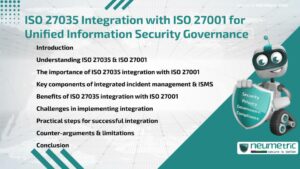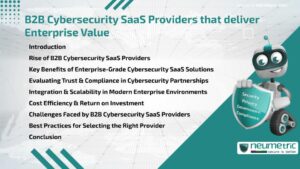Table of Contents
ToggleIntroduction to Mapping ISO 27001 Clauses to Controls
Understanding how to map ISO 27001 clauses to controls is essential for any organisation working toward Information Security Management System [ISMS] Compliance. This mapping process links the high-level requirements outlined in the ISO 27001 Standard to specific, actionable controls that enforce those requirements.
Done correctly, this mapping strengthens internal processes, enhances Audit preparedness & supports a culture of Continuous Improvement in Information Security.
What Are ISO 27001 Clauses & Controls?
ISO 27001 includes two major parts relevant to Compliance. The first part (Clauses 4 to 10) outlines the foundational activities required to build & operate a functioning Security framework. These include setting objectives, defining responsibilities & evaluating performance. This section of the Standard focuses on defining the organisation’s Security landscape by identifying its purpose, assigning key responsibilities, setting Risk-based goals, allocating supporting resources, executing security processes, evaluating outcomes & ensuring ongoing enhancements.
The second part, referred to as Annex A, lists a total of ninety-three (93) Control options. These controls are provided as a reference catalogue to help organisations manage identified Risks in a structured & consistent way. They are organised into four key categories: Policies & oversight, employee-related precautions, facility-based security controls & technology-driven defenses. These controls provide practical measures that align with & help fulfil the broader requirements defined in the main clauses.
To understand how to map ISO 27001 clauses to controls, you must first distinguish between these clauses (which explain what needs to be achieved) & the controls (which explain how it can be achieved).
Why Mapping Clauses to Controls Matters in Compliance?
Mapping clauses to controls ensures every high-level requirement has a concrete implementation pathway. This structured approach:
- Helps demonstrate Compliance during Audits
- Clarifies ownership & accountability
- Minimises the likelihood of missed areas or duplicated efforts in implementing security measures
- Offers a well-defined Framework that guides both execution & internal Review processes
For example, Clause 6 (Planning) requires organisations to address Risks & opportunities. Mapping this to controls such as A.5.4 (Management responsibilities) & A.8.3 (Information Security Risk treatment) makes this clause actionable.
Guide to Linking ISO 27001 Clauses & Controls
Step 1: Understand Clause Requirements
Carefully examine & understand the content outlined in Clauses 4 through 10 of the ISO 27001 Standard. Identify the expectations such as defining the ISMS scope, roles, Risk planning & Continuous Improvement.
Step 2: Review Annex A Controls
Familiarise yourself with the list of controls in Annex A. Grouped into categories, these controls are designed to mitigate Risks & ensure security objectives are met.
Step 3: Identify Logical Connections
Look for natural alignments. For instance, the requirement in Clause 9.1, which focuses on tracking, assessing & reviewing performance, aligns well with Control A.12.4 that addresses system logging & monitoring activities.
Step 4: Document the Mapping
Use a spreadsheet or GRC tool to list each clause alongside its associated control(s). Provide explanations for how each control satisfies the clause.
Step 5: Validate with Internal Stakeholders
Engage Compliance, IT & operations teams to ensure that the mapping is accurate & practical.
Step 6: Update Periodically
Whenever your ISMS changes or when ISO standards are revised, revisit the mapping to ensure continued relevance.
Common Pitfalls to avoid During Mapping
While learning how to map ISO 27001 clauses to controls, many organisations fall into avoidable traps:
- Over-Mapping: Assigning too many controls to a single clause creates confusion.
- Under-Mapping: Ignoring relevant controls leaves Compliance gaps.
- Assuming One-to-One Relationships: Some clauses will align with multiple controls & vice versa.
- Failing to Consider Risk Context: Mapping must be informed by a real understanding of organisational Risks.
How Internal Audits Rely on Clause-to-Control Mapping?
Internal auditors often begin their review by analysing how well clauses have been implemented through mapped controls. Clear mapping:
- Supports Audit checklists
- Shows which departments are responsible for which controls
- Helps identify gaps or Non-Conformities quickly
Knowing how to map ISO 27001 clauses to controls improves both Audit outcomes & operational maturity.
How Mapping Supports Risk Treatment Plans?
A strong ISMS is Risk-driven. The mapping process connects each Risk-related clause with the control(s) designed to treat that Risk.
For example:
- Clause 6.1.3 (Risk treatment plan) aligns with control A.8.3 (Information Security Risk treatment).
- Clause 8 (Operation) often maps to controls in Annex A.12 (Operations security).
This helps security teams justify why certain controls were chosen & demonstrate this alignment during external assessments.
Risks & Gaps in Clause-Control Mapping
Although mapping plays a crucial role in ISO 27001 implementation, it should not be seen as a one-size-fits-all solution. Limitations include:
- It does not replace a full Risk Assessment
- It may vary across different industries & contexts
- Over-reliance on templates may create blind spots
To make the most of it, organisations need to tailor the mapping process to fit their actual operations, business needs & evolving threat landscape.
Takeaways
- The main clauses in ISO 27001 outline what must be achieved at a strategic level, while the Annex A controls guide organisations on how those goals can be practically implemented.
- Mapping links both, ensuring operational alignment & Audit readiness.
- By learning how to map ISO 27001 clauses to controls effectively, companies can minimise risks, boost operational efficiency & strengthen their overall compliance posture.
- Use tools & templates, but always validate mappings with internal teams.
- Periodic Review is essential to keep mappings relevant.
FAQ
What is the purpose of mapping ISO 27001 clauses to controls?
Mapping shows how organisational actions satisfy Standard requirements, helping improve clarity, Compliance & Audit preparedness.
Can one clause map to multiple controls?
Yes, most clauses require multiple controls to fully implement the requirement. Mapping is often one-to-many or many-to-one.
Is mapping mandatory for ISO 27001 Certification?
While not explicitly required, mapping makes implementation & Audit easier & is often expected during certification reviews.
Do tools automate how to map ISO 27001 clauses to controls?
Yes, several tools can assist with auto-mapping based on Best Practices but should be reviewed manually for accuracy.
How often should the clause-to-control mapping be updated?
Ideally, mappings should be reviewed every six (6) to twelve (12) months or when significant changes occur in your ISMS.
What happens if mappings are incomplete?
Incomplete mappings can lead to Audit Findings, missed requirements & potential security Risks due to unaddressed clauses.
Can organisations use ready-made formats to connect ISO 27001 clauses with applicable controls?
Yes, many free & paid templates are available online through non-commercial sources & Compliance platforms.
Is mapping the same for every organisation?
No, mapping should reflect your specific context, Risks & organisational structure to be effective.
Need help?
Neumetric provides organisations the necessary help to achieve their Cybersecurity, Compliance, Governance, Privacy, Certifications & Pentesting goals.
Organisations & Businesses, specifically those which provide SaaS & AI Solutions, usually need a Cybersecurity Partner for meeting & maintaining the ongoing Security & Privacy needs & requirements of their Clients & Customers.
SOC 2, ISO 27001, ISO 42001, NIST, HIPAA, HECVAT, EU GDPR are some of the Frameworks that are served by Fusion – a centralised, automated, AI-enabled SaaS Solution created & managed by Neumetric.
Reach out to us!





